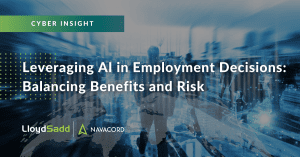Leveraging AI in Employment Decisions: Balancing Benefits and Risk

Organizations are increasingly utilizing artificial intelligence (AI) in employment-related decisions. According to the Society for Human Resources Management, around 25% of organizations use AI technology for HR processes, such as recruitment, hiring, performance evaluations and retention determinations.
Although AI technology can offer several benefits (e.g., improved efficiency, objectivity and decision-making), it also presents challenges related to potential biases, transparency issues and ethical concerns. This article examines the pros and cons of leveraging AI technology in employment decisions, discusses relevant laws and regulations for businesses to consider, and provides tips on mitigating AI-related risks.
Current Applications of AI Technology in Employment Decisions
AI technology is utilized in multiple aspects of employment decisions, including the following:
- Recruitment and candidate screening—AI tools help match potential employees to open positions and scan resumes for keywords and phrases. In some instances, companies may utilize these tools to assess candidates’ interview responses or even interact directly with potential hires.
- Hiring and onboarding—AI technology streamlines processes during hiring and onboarding, reducing redundancies and checking for incomplete responses. It can also be utilized to personalize and improve the hiring and onboarding experience.
- Performance evaluation and feedback—AI technology provides real-time assessments and collects and analyzes performance data. The information can then be used to provide targeted and timely feedback to employees and assist leaders in making promotion and retention decisions.
Benefits of Using AI Technology in the Employment Process
How and when businesses choose to implement AI tools can vary, but, in general, the utilization of this technology may offer several benefits. These include the following:
- Improved efficiency and time savings—AI technology automates repetitive, time-consuming tasks and frees up hours for HR personnel to focus on other essential duties.
- Enhanced objectivity and reduced bias—When properly implemented, AI tools can increase the overall fairness of the employment process. For example, algorithms can be written to consider objective characteristics in resumes that can reduce bias in the selection process.
- Predictive insights for better decision-making—AI technology’s data analysis capabilities offer predictive insights that can improve organizational decision-making. For instance, it can produce extensive reports with detailed metrics that could aid in leadership determinations.
Risks of Using AI Technology in Employment Decisions
While AI technology offers many benefits, its utilization also comes with several risks, such as the following:
- Perpetuating potential biases and discrimination—Although AI technology can reduce biases and discrimination, it also has the capability of perpetuating them if not properly designed, implemented and monitored. For example, since AI systems rely on data inputs, they may identify job candidates who mirror an existing workforce. If that original workforce is predominately composed of a particular demographic, AI tools may then build a candidate pool that reflects those characteristics while discriminating against other applicants.
- Lack of transparency and interpretability—The lack of clarity behind AI-based decision-making can create challenges in interpreting and providing precise reasons for candidate selection or rejection. For instance, suppose candidates follow up with a company asking for more information as to why they were not selected for an interview. It may be challenging to articulate the precise reasons since AI technology was utilized in making the determination.
- Ethical concerns regarding privacy and data protection—Utilizing and storing individuals’ personal data in AI systems raises ethical and legal considerations, requiring companies to have appropriate policies in place (e.g., receive consent before it is used) as well as having systems to safeguard this information (e.g., securely storing it, disseminating it to only necessary decision-makers and destroying it when it is no longer needed).
Regulatory and Legal Considerations
When utilizing AI to make employment decisions, businesses must adhere to applicable laws and regulations, such as the Canada Human Rights Act and the Personal Information Protection and Electronic Documents Act.
Various provinces or cities may have additional laws that apply when using AI technology in employment decisions. In fact, the Ontario government is developing AI guidelines, so additional regulations for AI tools could be produced in the future.
Businesses must stay abreast of legal developments regarding AI technology use; failing to comply with applicable regulations could result in fines, penalties and reputational damage.
Mitigating Liability and Reducing Risks
To mitigate potential liability and reduce risks related to AI technology use, organizations can implement the following strategies:
- Comply with applicable laws and regulations. Businesses need to make certain they are permissibly using AI technology in employment-related decisions. Working with the AI vendor to understand its algorithm, consulting with legal professionals about the applicable laws and regularly monitoring the technology’s outputs for discriminatory results may help them do so.
- Develop clear ethical guidelines. Internal policies should address appropriate usage, detail consent procedures for candidates and employees, and emphasize the transparency of AI algorithms.
- Ensure data quality to minimize bias. Since AI technology can perpetuate unlawful biases, it is imperative for the data inputted into these systems to be accurate, diverse, relevant and complete. This can help these systems produce stronger and more compliant results.
- Implement human oversight and intervention. Human involvement in decision-making processes is crucial to ensure legal and proper functioning of AI systems.
- Audit and evaluate AI technology’s performance regularly to address emerging risks. Similar to other systems, AI technology needs to be audited on a regular basis to analyze its outputs. Adjustments and corrections can then be made to improve its performance.
Conclusion
AI technology use in employment decision-making is on the rise, and its utilization presents various benefits and risks. Businesses must be aware of the positives, negatives and legal concerns of this technology to be able to properly incorporate it.
For more risk management guidance, contact us today.
To download the insight, click here:[Cyber]_Leveraging AI in Employment Decisions Balancing Benefits and Risks_LS